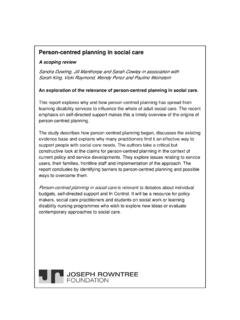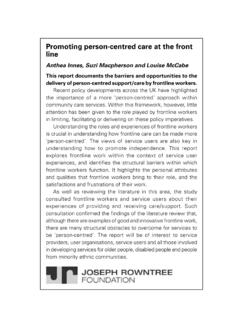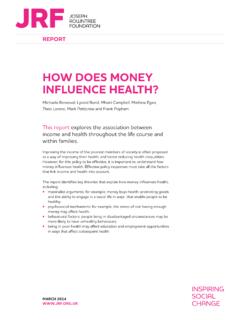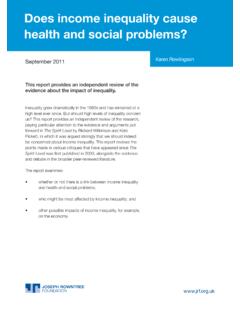Transcription of The social value of public spaces - JRF | The Joseph ...
1 The social value of public spaces public spaces play a vital role in the social and economic life of communities. New kinds of public spaces and meeting places are now being created in towns and cities, which can be an important social resource. In this summary of research projects undertaken in England and Wales, Ken Worpole and Katharine Knox explore how people use both traditional and new public spaces , and how these places function, often successfully, sometimes not. The summary provides clear evidence of the importance of public space in successful regeneration policies, and for creating sustainable communities.
2 Key findings public spaces (including high streets, street markets, shopping precincts, community centres, parks, playgrounds, and neighbourhood spaces in residential areas) play a vital role in the social life of communities. They act as a self-organising public service', a shared resource in which experiences and value are created (Mean and Tims, 2005). These social advantages may not be obvious to outsiders or public policy-makers. public spaces offer many benefits: the feel-good' buzz from being part of a busy street scene; the therapeutic benefits of quiet time spent on a park bench; places where people can display their culture and identities and learn awareness of diversity and difference; opportunities for children and young people to meet, play or simply hang out'.
3 All have important benefits and help to create local attachments, which are at the heart of a sense of community. The success of a particular public space is not solely in the hands of the architect, urban designer or town planner; it relies also on people adopting, using and managing the space people make places, more than places make people. The use of public spaces varies according to the time of day and day of the week, and is affected by what is on offer in a particular place at a particular time. In one town centre studied there was a clear rhythm to the day, with older people shopping in the central market early on, children and young people out at the end of the school day, and young adults dominating the town centre at night.
4 Some groups may be self-segregating in their use of different public spaces at different times, with social norms affecting how and whether people engage with others. public spaces are a particular and distinct resource for young people looking to socialise with others. However, groups of young people are sometimes perceived as having antisocial intentions, which in many cases is simply not true. Retailing and commercial leisure activities dominate town centres, and though public space can act as a social glue' the research found that in some places the society that is being held together is a stratified one, in which some groups are routinely privileged over others' (Holland et al, 2006).
5 So, for instance, young and older people are discouraged from frequenting shopping areas by lack of seating or (for groups of younger people) by being moved on'. 2 I The social value of public spaces The research challenges several current government policy assumptions concerning public space. The urban renaissance' agenda appears too concerned with matters of urban design, as well as being distinctly metropolitan in character. The majority of public spaces that people use are local spaces they visit regularly, often quite banal in design, or untidy in their activities or functions (such as street markets and car boot sales), but which nevertheless retain important social functions.
6 The research questions whether the government's emphasis on crime and safety in public spaces is depriving them of their historic role as a place where differences of lifestyles and behaviour are tolerated and co-exist. What is considered antisocial behaviour' may vary from street to street, from one public situation to the next, or from one person to the next. It is also important for policy-makers and practitioners to recognise that so-called marginal or problem groups, such as young people, or street sex workers, are also a part of the community. Definitions of community' that exclude particular groups are of questionable legitimacy in the long term.
7 Regeneration strategies or policing approaches intended to design out crime' can end up designing out' people. Approaches that strip public spaces of all features vulnerable to vandalism or misuse actively discourage local distinctiveness and public amenity. The social value of public spaces I 3. Introduction: Challenging conceptions The public spaces discussed here encompass those of public spaces neighbourhood spaces that are less clearly in the The concept of what public spaces ' are changes over regeneration policy spotlight but are important to the time. The public spaces examined in the research government's cleaner, safer, greener agenda as in the projects cited here include areas traditionally deemed as Communities and Local Government's reports, Living public open spaces , such as high streets, street markets, Places: Cleaner, Safer, Greener (2002) and Living Places: parks, playgrounds and allotments.
8 The projects also Caring for Quality (2004). explored places that are widely used by the public but may be privately owned, including shopping precincts and When added together, the individual interviews, street arts centres, and other fora where members of the public surveys, focus groups and observation exercises might convene, such as car boot sales. conducted through the JRF's public spaces Programme's research represent one of the largest reviews of the use of Some studies also looked at the use of less typical everyday public spaces undertaken. places, termed quasi- public spaces ' or micro- spaces ', such as station forecourts, and stairwells or street corners Key findings of housing estates.
9 Many of these spaces have been public space is not shrinking, but expanding characterised as everyday spaces ' (Mean and Tims, Contrary to conventional assumptions, public space in 2005), a term that conveys something of their casual, neighbourhoods, towns and cities is not in decline but daily, functional use. is instead expanding. Concerns have been expressed that open and uncontrolled public spaces , sites of In this sense, the public spaces surveyed went beyond unpredictable encounter', have been increasingly the definition of public space' currently prevailing in privatised and made subject to controls and surveillance.
10 Urban design policies based on the urban renaissance While this was evident in some of the studies, this agenda. These often tend to concentrate on town centres programme suggests there is a need to reframe debates and metropolitan spaces , where retailing and tourism more broadly in light of how people use different places. needs and interests (and inter-city competitiveness) are considered to be the more important strategic goals. As There has been a tendency to confine notions of one study noted, Discussions on regeneration in central public space to traditional outdoor spaces that are in and local government as well as the media are typically public ownership, but opportunities for association and dominated by architectural and design prescriptions about exchange are not so limited.









